#Prosper Merimée
Text
El tacto (serie de Tapices de la Dama y el Unicornio)
Vamos a seguir con el examen de esta maravillosa obra de arte que son los tapices llamados “de la Dama y el Unicornio”, expuestos a día de hoy en el Museo de Cluny o de la Edad Media de París (Francia). Ya he examinado los correspondientes a la vista, el tacto, el gusto y el oído. Nos queda, por tanto, el del olfato que trataremos en esta entrada y el enigmático “A mon seul desir” (A mi sólo /…

View On WordPress
#Artes decorativas#Edad Media#En Español#Francia#Jean Le Viste#Museo de Cluny#Prosper Merimée#Siglo XV#Tapices
1 note
·
View note
Text
Las ánimas del Purgatorio (Le anime del Purgatorio), racconto del 1834 di Prosper Merimée.
3 notes
·
View notes
Text

Tina Aumont interview 4
I would even say more, you shot a very beautiful film adapted from "Carmen" by Prosper Merimée in which you had the leading role.
Yes, by miracle.
Do you have a story about this?
The filming was indeed epic. Horses, flamenco of course. The story of Carmen with Franco Nero in the role of Don José, and Klaus Kinski in the role of my husband. Kinski who, contrary to his legend, did not create the slightest problem, nor even later on other shoots.
In 68, Partner of Bernardo Bertolucci. I was very happy to play in it. I had eyes painted on my eyelids. In the film, I arrive at Pierre Clementi's house to sell him detergents. I actually remember that, as it was 68, Bertolucci was afraid that Clémenti and I would leave the set.
Did you feel concerned about the problem?
Yes, it was difficult not to be concerned, but I was not on the barricades. In Italy, there were fewer riots, much less. The Italian students felt concerned, but there were fewer movements of revolt. For us French people, it was strange to be in Rome.
Still in 68, Satyricon, but not that of Fellini, that of Gianluigi Polidoro, shot in the same spirit?
A little, more kitsch in terms of the costumes and sets, the makeup. I played the goddess Circe. The story revised and corrected by Gianluigi Polidoro. Otherwise, before Carmen, I acted in a film by Alberto Sordi in 66, “Scusi lei e favorevole o contrario?”. This is where I met Fellini, because he was a friend of Sordi.
Tina interviewed by Antoine Cervero in 2001. Published in January/June 2002 Cine Zine Zone number 134.
Very special thanks to @74paris for sharing this gem.
#Tina Aumont#actress#Antoine Cervero#Cine Zine Zone#2001 Cine Zine Zone#2001 events candids#collaboration#2001#2002
10 notes
·
View notes
Text
0 notes
Text

Lokis. Rekopis profesora Wittembacha
(Lokis. Manuscrito do professor Wittembach)
PL, 1970
Janusz Majewski
6/10
.
Os Ursos da Lituânia
Uma incursão curiosa no universo fantástico num filme polaco de 1970, realizado por Janusz Majewski, baseado num conto do romântico francês Prosper Merimée.
Uma viagem à Lituânia do século XIX de um pastor em busca das raízes folclóricas da região, onde vai encontrar uma estranha ligação entre uma nobre família de Vilnius e os ursos que povoam o seu território.
Além dessa leitura literal de um conto fantástico, que tanto agradava aos românticos, permito-me extrair uma interpretação mais política do filme. Considerando o momento histórico da Polónia em 1970 este filme pode também ser lido como uma critica à aristocracia decadente e fútil e uma lembrança ao poder soviético que a Lituânia era cultural e historicamente parte da Polónia, apesar da invasão ordenada por Stalin em 1939, no decurso do infame pacto Molotov-Von Ribbentrop, que dividiu a Polónia entre nazis e soviéticos. Ou não.
.
The Bears of Lithuania
A curious foray into the fantastic universe in a 1970 Polish film, directed by Janusz Majewski, based on a short story by the French romantic Prosper Merimée.
A pastor's journey to 19th century Lithuania in search of the region's folkloric roots, where he will find a strange connection between a noble Vilnius family and the bears that populate their territory.
In addition to this literal reading of a fantastic tale, which romantics loved so much, I allow myself to extract a more political interpretation of the film.
Considering Poland's historical moment in 1970, this film can also be read as a critique of the decadent and futile aristocracy and a reminder to Soviet power that Lithuania was culturally and historically part of Poland, despite the invasion ordered by Stalin in 1939, in the course of the infamous Molotov-Von Ribbentrop Pact, which divided Poland between the Nazis and the Soviets. Or not.
0 notes
Text





Amandine Albisson & Stéphane Bullion
Paris Opera Ballet
Carmen, Roland Petit@
© Anne Ray
#amandine albisson#stephane bullion#stéphane bullion#paris opera ballet#ballet de l'opéra national de paris#roland petit#carmen#ballet#georges bizet#prosper merimée#antoni clavé#jean-michel désiré
10 notes
·
View notes
Text
FRASE: LA QUINTA COLUMNA

EL POSIBLE AUTOR DE LA EXPRESIÓN
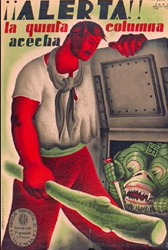

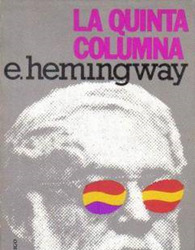
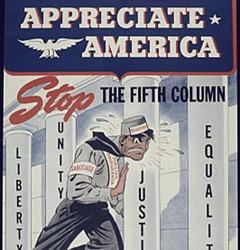
CARTEL ESTADOUNIDENSE CRITICANDO LAS ACCIONES DE LA QUINTA COLUMNA

LAS CARTAS DE MERIMÉE A EUGENIA DE MONTIJO
Resulta muy curioso que las dos expresiones asociadas a su creación en la guerra civil española de 1936, una por cada bando, sean realmente de otro origen: NO PASARÁN y la que hoy nos ocupa, LA QUINTA COLUMNA.
Ya vimos como la frase No Pasarán tuvo su origen en la I Guerra Mundial o incluso en 1822. En este caso la expresión LA QUINTA COLUMNA, se considera un neologismo y aunque se ha atribuido su paternidad a los rebeldes en la guerra civil española parece que tampoco tuvo su origen en esas fechas sino varias décadas antes. Lo que si es cierto es que su difusión internacional, pues se trata de un término usado en diferentes idiomas, se popularizó a raíz de nuestra guerra civil.
Según la Wikipedia LA QUINTA COLUMNA es una expresión utilizada para designar, en una situación de confrontación bélica, a un sector de la población que mantiene ciertas lealtades (reales o percibidas) hacia el bando enemigo, debido a motivos religiosos, económicos, ideológicos o étnicos. Tal característica hace que se vea a la quinta columna como un conjunto de personas potencialmente desleales a la comunidad en la que viven y susceptibles de colaborar de distintas formas con el enemigo”. A los componentes de la Quinta Columna se les denomina coloquialmente quintacolumnistas.
La historia canónica de la expresión es la siguiente: en las primeras semanas de la guerra civil de 1936, al General Mola, el gris militar que organizó técnicamente el golpe de estado no se le ocurre decir una mayor estupidez en un discurso radiofónico que las tropas levantadas estaban atacando Madrid con cuatro columnas diferentes. Una desde Toledo, otra por la carretera de Extremadura, la tercera por la Sierra y una cuarta desde Sigüenza, pero que también contaba con una QUINTA COLUMNA que actuaba en el interior de la capital de España compuesta por los simpatizantes del levantamiento y que estaban dispuestos a ayudar en lo posible para la victoria del ejército rebelde. Estas palabras en un Madrid continuamente bombardeado que ocasionaban numerosa víctimas civiles, prácticamente cercado y con un gran vacío de poder, con las milicias de los diferentes partidos y sindicatos erigidas en autoridad total supuso una condena de muerte de decenas de opositores a la República que estaban encarcelados y que sufrieron el asalto de las masas desbordadas que se tomaron la justicia y la venganza de forma arbitraria. Hugh Thomas lo narra así: “Mola instaló su cuartel general en Ávila, para lanzar el asalto general contra Madrid. Parece cierto que, cuando un grupo de periodistas extranjeros, le preguntó cuál de sus cuatro columnas conquistaría Madrid, él contestó que sería la ‘quinta columna’, es decir, la de los partidarios nacionalistas que en secreto se encontraban dentro de la ciudad. Estas imprudentes palabras constituyeron el pretexto de innumerables asesinatos en la Capital”.
Según otras fuentes como las del hombre fuerte de Stalin en Madrid, Mijail Koltsov (luego fusilado por el propio Stalin) la autoría de la frase corresponde al general Varela. Lo cierto es que la expresión tuvo éxito y en los siguientes conflictos bélicos fue muy utilizada en diferentes países tanto en el bando aliado como en los del Eje. El miedo a la Quinta Columna hizo que los japoneses en Estados Unidos o los alemanes en el Reino Unido y en la Unión Soviética fuesen recluidos en campos de internamiento (unos campos de concentración light, para entendernos).
Pero varias realidades se ciernen tanto sobre la autoría como, sobre todo, con la difusión de la frase: quien le dio amplia dimensión internacional a la expresión fue Ernest Hemingway cuando estrenó en 1938 su única obra de teatro con el título La Quinta Columna ambientada en la guerra civil española.
Las otras dos realidades (o posibilidades) nos hacen remontarnos muchos años atrás. Algún historiador ha encontrado esta expresión durante el asedio a la fortaleza turca de Ismail en 1790 por parte del general Alexandre Vasilievich Suworow, aplicada a los partidarios rusos que estaban viviendo dentro de la citada fortaleza.
Hay un dato más concreto y posterior en el tiempo. En la correspondencia entre Prosper Merimée y la Emperatriz Eugenia de Montijo, el escritor francés pone en la boca de esposa de Napoleón III una expresión similar pero llevada solo a “un cuarto ejército”: una referencia a los tres ejércitos prusianos que sitiaban París en 1870: Il y a la quatrième armée de M. de Bismarck, et celle-là est à Paris. (Hay el cuarto ejército del Sr. Bismarck y ese está en París.)
Hoy la expresión se sigue usando en ámbitos menos belicosos que los que hemos señalado y forma parte del lenguaje coloquial. Desgraciadamente también es usada esta expresión por algunas organizaciones de extrema derecha europeas que quieren alertar sobre la infiltración islámica del viejo continente, indicando que los musulmanes que viven en las capitales europeas son la quinta columna del islamismo para derrotar la cultura cristiana occidental.
25/6/2021
2 notes
·
View notes
Photo

Prosper Merimée (1803–1870), French man-of-letters, historian and novelist by Pierre Jean David d'Angers, Metropolitan Museum of Art: European Sculpture and Decorative Arts
Gift of Samuel P. Avery, 1898 Metropolitan Museum of Art, New York, NY
Medium: Bronze, brown patina, hollow cast
http://www.metmuseum.org/art/collection/search/210290
2 notes
·
View notes
Text
Stendhal (Henri Beyle), a Napoleonic era personality
From a short piece called “H.B.” written by his friend Prosper Merimée, after Beyle’s death. The whole thing is pretty entertaining.
It was difficult to know what he thought about Napoleon. He was almost always in disagreement with whatever side was argued. Sometimes he spoke of him as a social climber, dazzled by the finery, who never obeyed the laws of logic. Other times he would speak with an admiration approaching idolatry. One moment he was a mudslinger like Courier and the other as servile as Les Cases. The men of the empire were treated as inconsistently as their master.
He agreed that the emperor had an amazing charisma that affected everyone who came before him. “And I also had the eternal flame. I was sent to Brunswick to raise an extraordinary levy of five million francs. I was able to collect seven and managed to avoid being attacked by the rabble, who were up in arms at my excessive zeal. The emperor, however, asked which auditor was responsible and just said: “That’s good.”
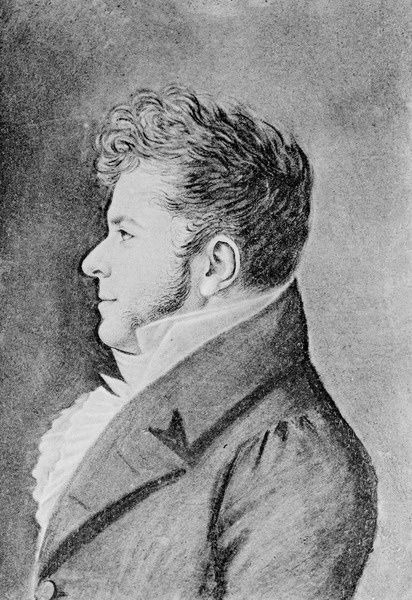
In 1813 B. [Beyle] was witness to the rout of an entire brigade caught unawares by five Cossacks. B. saw around two thousand men running away, including five generals, identifiable by their rimmed hats. He ran like the others but not very fast as he only had one boot at the time and carried the other in his hand. In the entire French corps there were only two heroes who turned to fight the Cossacks: a gendarme called Menneval and a conscript, who killed the gendarme’s horse by mistake as he tried to fire at the Cossacks. B. was given the task of telling the emperor about the stampede, who listened in silent fury while playing with the iron device used to fasten the shutters. They looked for the gendarme to give him the cross but he was hiding, and denied at first that he was even present at the time, as he was sure that nothing was worse than to be identified in the midst of a rout. He was convinced he was going to be shot.
1 note
·
View note
Text
I don’t love you anymore. You love me still, and that is why you want to kill me. If I liked, I might tell you some other lie, but I don’t choose to give myself the trouble. Everything is over between us two. You are my rom, and you have the right to kill your romi, but Carmen will always be free. A calli she was born, and a calli she’ll die
- Prosper Merimée, Carmen
4 notes
·
View notes
Text

Interview with Tina Aumont 3
Following that, in 66 there was “La Curé” by Roger Vadim, with Jane Fonda. Do you have good memories of it?
Very good. Christian Marquand, my husband at the time, was Roger Vadim's best friend, and I practically filmed with family. I haven't seen Vadim for a while, but we've kept in touch.
Still in 66, you played in “Texas across the River” by Michael Gordon.
Yes, it was quite unexpected. This is Alain Delon's first American film. I had tried out for the role of an Indian woman engaged to Delon. It's a western-comedy, a really good one, too, with Dean Martin. Hollywood filming, with the construction of a city in the middle of the desert. In there, I play the Colt! I gallop a little everywhere. I'm doing others in Italy. So, I later played Calamity-Jane in Luigi Bazzoni's Blu Gang in 1973.
In 67 we discovered you in “Troppo per Vivere, poco per morire...” by Michele Lupo.
Yes, I think it's a detective story. Apparently, it didn't impact me too much. I filmed in a version of Carmen by Prosper Merimée, entitled “Man, Pride, Vengeance” by Luigi Bazzoni with Klaus Kinski. A very beautiful film. Luigi Bazzoni made a career on his side. He had previously directed “La Femme du Lac”, a film with Virna Lisi. Another beautiful film, detective this one. He remained a friend.
Tina interviewed by Antoine Cervero in 2001. Published in January/June 2002 Cine Zine Zone number 134.
Very special thanks to @74paris for sharing this gem.
#Tina Aumont#actress#Antoine Cervero#Cine Zine Zone#2001 Cine Zine Zone#2001 events candids#collaboration#2001#2002
7 notes
·
View notes
Text

The Lady and the Unicorn (circa 1500)
6 Tapestries (5 about the five senses and one with the words "À mon seul désir".
Each tapestries depicts a noble lady with the unicorn
On these tapestries there is the arms of Jean Le Viste, a powerful nobeman in the court of King Charles VII. But nowadays recent studies thought that the sponso was Antoine II Le Viste.
These tapestries were rediscovered by Prosper Merimée in Boussac castle in 1841.
Today you can see them in Paris in the Musée de Cluny
You can also see them in the Harry Potter film series. They were used to cover the bare stone walls in the Gryffindor Common Room.
#la dame a la licorne#the lady and the unicorn#tapestrydecor#tapestries#tapestryart#medieval#medieval stuff#medieval art#1500#history#medieval history
26 notes
·
View notes
Text
AN INCOMPLETE HISTORY OF MEDIEVAL ART LIX
Nôtre Dame de Paris




The fourth of five posts on the long, complex history of the Cathedral of Nôtre Dame.
IV. The Nineteenth-Century Restoration
Sans doute, c’est encore aujourd’hui un majestueux et sublime édifice que l’église de Notre-Dame de Paris. Mais si belle qu’elle se soit conservée en vieillissant, il est difficile de ne pas soupirer, de ne pas s’indigner devant les dégradations, les mutilations sans nombre que simultanément le temps et les hommes ont fait subir au vénérable monument. Victor Hugo, Nôtre Dame de Paris, 1831.
Restaurer un édifice, ce n’est pas l’entretenir, le réparer ou le refaire, c’est le rétablir dans un état complet qui peut n’avoir jamais existé à un moment donné. Eugène Viollet-le-Duc
Victor Hugo’s novel, Nôtre Dame de Paris (1831) drew attention to the deplorable condition of the Gothic cathedral of Paris. The novel’s success was partvof a reawakening of interest in medieval art and history, which had long been denigrated and ignored. In 1841, recognizing the nationalistic value of a monument created in an indigenous French style, the July monarchy formed a committee to gather professional opinions concerning the 700 year-old edifices’s condition. Based on the committee’s findings, in 1844, King Louis-Philippe ordered a sweeping preservation program including the complete restoration of Nôtre Dame and the construction of a new sacristy.

above: Nôtre Dame as construction site, c. 1850
The architects chosen to rebuild Nôtre Dame, Jean-Baptiste Lassus and Eugène Viollet-le-Duc, had just completed the restoration of the Sainte Chappelle. Prior to that Viollet-le-Duc had also rebuilt the monastic church of Vézelay, which saved it from imminent collapse. Other than experience, there were few established protocols or resources to consult concerning the restoration of medieval buildings and the scope of the Nôtre Dame project was daunting: the mortar binding the ashlar masonry had eroded to the extent that pieces of stone fell to the ground on a daily basis. The stained glass of the clerestory had been replaced with 18th-century grisaille glass. After centuries of neglect, during the violent period of the Revolution, the cathedral had been deconsecrated and its sculpture defaced or crudely hacked off the building by the mobs. The crossing spire had been declared unstable and removed in the 1830s. The bishop’s palace was crumbling into the Seine.
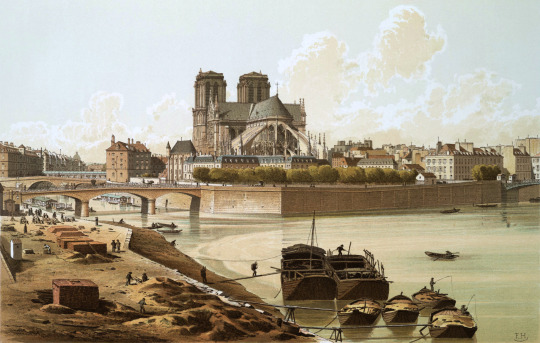
above: The Ile-de-la-Cité c. 1830
In the Conseils pour la restauration en 1849, the co-authors Viollet-le-Duc and the Inspecteur Général des Monuments Historiques, Prosper Merimée, state that:
Les architectes attachés au service des édifices diocésains, et particulièrement des cathédrales, ne doivent jamais perdre de vue que le but de leurs efforts est la conservationde ces édifices.
In practice st Nôtre Dame, however, Viollet-le-Duc’s approach to historical monuments restoration was idealist and holistic. For him, the cathedral’s form existed independently of the materials that composed it at any given time; therefore the form, and not the materials, were the object of restoration. The medieval building fabric would be replicated, but the retention of original stone and glass was not essential. Gothic masonry could be recut or removed to implement a gothicizing solution that harmonized better with the totality of the building, or redesigned, if necessary, to assure structural and or aesthetic integrity. Where there was doubt about original appearances or configurations, other Gothic cathedrals would serve as models. The result would be half recreation of the historical cathedral of Paris, half catalogue of 19th-century conceptions of architectural and sculptural ideas current in the twelfth and thirteenth centuries. A delapidated medieval building was transformed into a crisply pointed allegory of medieval architecture.

above: Viollet-le-Duc and Lassus, Nôtre Dame façade, 1847
When Viollet-le-Duc visited Pisa, he found the sight of the torre pendente to be “désagréable” and opined that it should be corrected. The imperative to “correct” irregularities and errors in the original construction is a defining component of his restoration practice at Nôtre Dame. He and Lassus went far beyond conserving the Gothic fabric and repairing damage and wear. Over the long course of its construction, multiple medieval revisions to the design had resulted in many irregularities and discontinuities, which posed no threat to structural integrity. For example, the chapels between the nave buttresses had been added at different times in the 13th and 14th centuries and differed in size and decoration. Together they formed a micro-history of the evolution of Gothic chapel design within the broader narrative of cathedral design.
Viollet-le-Duc demolished the back walls of all of chapels and rebuilt them to a uniform size to be flush with the buttresses and applied a generic decorative program across them all. This imposition of anachronistic notions of visual consistency deprived the building of massive amounts of 13th-century masonry and decorative carving and gratuitously obliterated a bit of architectural history. In the equally destructive “correction” of the perimeter wall of the ambulatory, a delicate business involving the shifting and rebuilding walls while they supported the vaults, excised still more medieval stone. As a result of these needless interventions, the lower level of the exterior masonry, which wraps around the entire building, is entirely 19th century work. This high-handed approach is an example of historical destruction, not preservation.
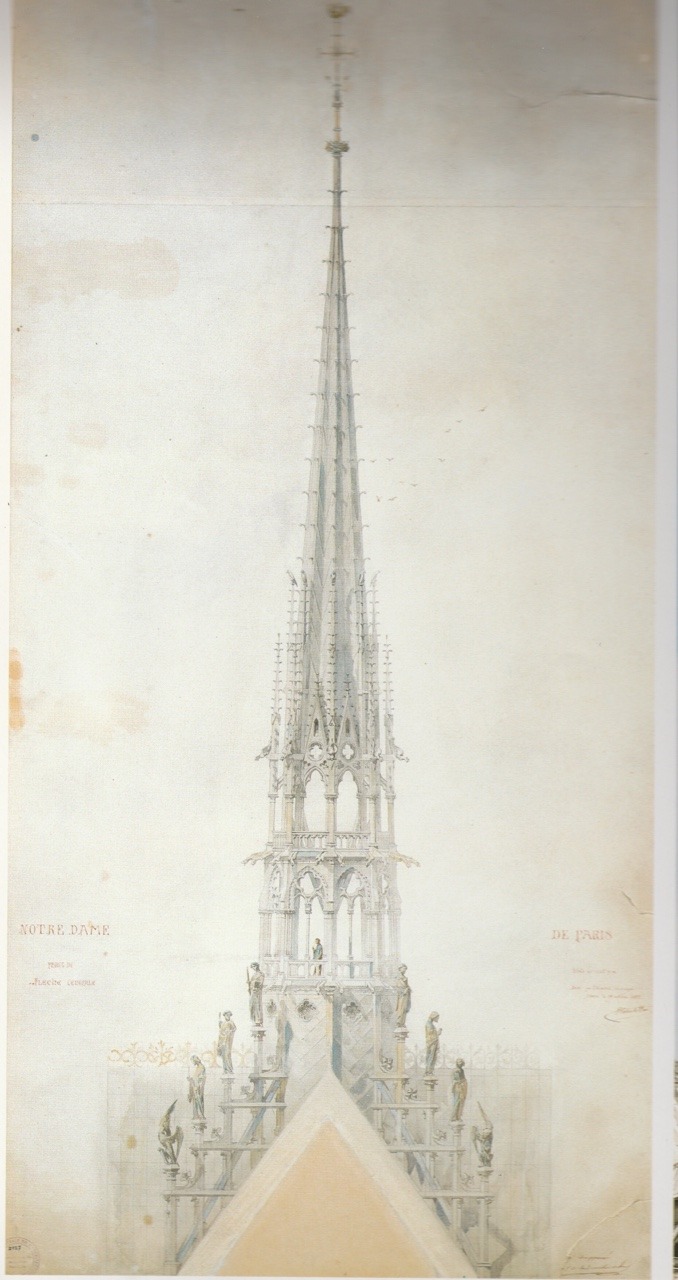
above: Viollet-le-Duc, design for Nôtre Dame flèche, c. 1855
Lassus and Viollet-le-Duc believed that the cathedral was incomprehensible without its sculpture and stained glass and insisted in their proposal that all of the stone sculpture be restored. As no reliable visual record of the sculptures existed, the team of 23 stone carvers were instructed to find and copy equivalents at Chartres, Reims, and Amiens. Based on different models, carved by numerous artists, at different times, the resulting “program” was unified by obliging the sculptors to work in a singie communal style. The sculptures of the façade formed a survey of Gothic cathedral sculpture that was then averaged and masked. The “restored” jamb figures did not replicate the originals nor did their style correspond to any historical medieval practice. The sculpture of the west portals are a misleading, medieval-flavored pastiche that blur rather than sharpen the view into French history supposedly provided by the cathedral.
When it showed signs of imminent collapse, the thirteenth-century spire had been removed in the 1830s. The plan submitted by the architects to the planning committee had included steeples, which had been planned in the Middle Ages but never built, but made no provision for restoring the spire. After the steeples were harshly criticized and dropped from the plan, the spire was added, relatively late in the project, to create a vertical accent. The absence of accurate, detailed images of the original did not stop Viollet-le-Duc from devising a convincing structure that represented a “typical” Gothic spire, but one that had no meaningful connection to the building. All the uninformed post-fire blather about the “iconic” spire completely misses this point.
The restoration of Nôtre Dame was completed in 1864, 20 years after it was launched. Lassus had died in 1857 and Viollet-le-Duc had become a celebrity, moving on to even larger projects like the restoration of the entire walled city of Carcassone. The cost of the cathedral restoration had been estimated at 2.6 million francs; in the end, it exceeded 10 million.
#historical preservation#restoration#viollet le duc#medieval architecture#gothic cathedral#nôtre dame#paris
22 notes
·
View notes
Quote
Era uma beleza estranha e selvagem, uma figura que surpreendia de início, mas que não se podia esquecer. Seus olhos, em particular, tinham uma expressão ao mesmo tempo voluptuosa e selvagem, que jamais tornei a notar em outro olhar humano. Olho de cigana, olho de lobo, é um ditado espanhol que veio a calhar.
Carmem, Prosper Merimée
#carmem#prosper merimée#literatura#arte#poesia#romance#espanha#flamenco#andaluzia#sevilha#cordoba#cigana#olhar#selvagem#capitu#machado de assis
0 notes
Quote
The word and its derivation ‘Satanist’ appeared for the first time in French and English in the sixteenth century during the European Wars of Religion. In publications from this period, Roman Catholic authors directed it against Protestant Christians, and vice versa, while both applied the epithet to Anabaptists. Their polemical use of the term did not necessarily mean that they thought their religious counterparts were self-consciously and secretly worshiping the devil – although mutual abuse might occasionally spill over into such allegations, particularly with regard to the Anabaptists – but rather that Roman Catholic veneration for ‘graven images’ or Protestant adherence to ‘heresy’ implied being a fellow-traveler on the bandwagon of Satan. In the early nineteenth century, the terms Satanist and Satanism acquired an even broader meaning and came to designate a person or thing with a ‘Satanic character’, a person or thing inherently evil or wicked. When Prosper Merimée (of Carmen fame) wrote in an 1842 letter to an anonymous female friend that she was making ‘quite rapid progress in Satanism’, he did not mean to say that she held regular rituals for the fallen angel, but that she was growing increasingly ‘ironic, sarcastic, and even diabolic’.
Satan Rehabilitated? - van Lujik, R. B.
5 notes
·
View notes
Text
Premiera operei „Carmen” de Georges Bizet (3 martie 1875)
Premiera operei „Carmen” de Georges Bizet (3 martie 1875)
Acum 146 de ani (3 martie 1875), la Opéra Comique din Paris, a avut loc premiera operei Carmen de Georges Bizet, libretul de Henri Meilhac şi Ludovic Halévy, după nuvela omonimă a lui Prosper Merimée.
Opera integral, Metropolitan Opera New York
Arhiva rubricii Filă de calendar
youtube
View On WordPress
0 notes